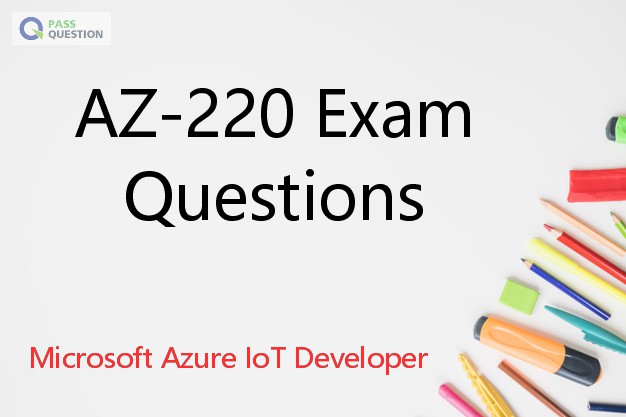AZ-220 Exam Questions - Microsoft Azure IoT Developer
Microsoft AZ-220 exam is a new exam of Microsoft Azure IoT Developer, if you passed this exam, you will be eligible for the Microsoft Certified: Azure IoT Developer Specialty certification.PassQuestion Microsoft AZ-220 Exam Questions will help you prepare for your AZ-220 exam. It covers the exam objectives and topics you will be tested on. PassQuestion Microsoft AZ-220 testing engine simulates the actual exam experience which can help you pass your AZ-220 exam successfully.

Microsoft Azure IoT Developer AZ-220 Exam Information
This Microsoft Certified Azure IoT Developer AZ-220 will provide you with the skills and knowledge required to successfully create and maintain the cloud and edge portions of an Azure IoT solution. It includes full coverage of the core Azure IoT services such as IoT Hub, Device Provisioning Services, Azure Stream Analytics, Time Series Insights, and more. In addition to the focus on Azure PaaS services, it also includes sections on IoT Edge, device management, monitoring and troubleshooting, security concerns, and Azure IoT Central.
The Azure IoT Developer is responsible for the implementation and the coding required to create and maintain the cloud and edge portion of an IoT solution. In addition to configuring and maintaining the devices by using cloud services, the IoT Developer also sets up the physical devices. The IoT Developer is responsible for maintaining the devices throughout the life cycle.
AZ-220 Exam Skill Measured - Microsoft Azure IoT Developer
Implement the IoT solution infrastructure (15-20%)
Provision and manage devices (20-25%)
Implement Edge (15-20%)
Process and manage data (15-20%)
Monitor, troubleshoot, and optimize IoT solutions (15-20%)
Implement security (15-20%)
View Microsoft Certified: Azure IoT Developer Specialty AZ-220 Free Questions
1. Note: This question is part of a series of questions that present the same scenario. Each question in the series contains a unique solution that might meet the stated goals. Some question sets might have more than one correct solution, while others might not have a correct solution.
After you answer a question in this question, you will NOT be able to return to it. As a result, these questions will not appear in the review screen.
You have an Azure IoT solution that includes an Azure IoT hub, a Device Provisioning Service instance, and 1,000 connected IoT devices.
All the IoT devices are provisioned automatically by using one enrollment group.
You need to temporarily disable the IoT devices from the connecting to the IoT hub.
Solution: From the Device Provisioning Service, you disable the enrollment group, and you disable device entries in the identity registry of the IoT hub to which the IoT devices are provisioned.
Does the solution meet the goal?
A. Yes
B. No
Answer: A
2.Note: This question is part of a series of questions that present the same scenario. Each question in the series contains a unique solution that might meet the stated goals. Some question sets might have more than one correct solution, while others might not have a correct solution.
After you answer a question in this question, you will NOT be able to return to it. As a result, these questions will not appear in the review screen.
You have an Azure IoT solution that includes an Azure IoT hub, a Device Provisioning Service instance, and 1,000 connected IoT devices.
All the IoT devices are provisioned automatically by using one enrollment group.
You need to temporarily disable the IoT devices from the connecting to the IoT hub.
Solution: You delete the enrollment group from the Device Provisioning Service.
Does the solution meet the goal?
A. Yes
B. No
Answer: B
3.You plan to deploy a standard tier Azure IoT hub.
You need to perform an over-the-air (OTA) update on devices that will connect to the IoT hub by using scheduled jobs.
What should you use?
A. a device-to-cloud message
B. the device twin reported properties
C. a cloud-to-device message
D. a direct method
Answer: D
4.You have an IoT device that gathers data in a CSV file named Sensors.csv. You deploy an Azure IoT hub that is accessible at ContosoHub.azure-devices.net. You need to ensure that Sensors.csv is uploaded to the IoT hub.
Which two actions should you perform? Each correct answer presents part of the solution. NOTE: Each correct selection is worth one point.
A. Upload Sensors.csv by using the IoT Hub REST API.
B. From the Azure subscription, select the IoT hub, select Message routing, and then configure a route to storage.
C. From the Azure subscription, select the IoT hub, select File upload, and then configure a storage container.
D. Configure the device to use a GET request to ContosoHub.azure-devices.net/devices/ContosoDevice1/ files/notifications.
Answer: AC
5.You plan to deploy an Azure IoT hub.
The IoT hub must support the following:
- Three Azure IoT Edge devices
- 2,500 IoT devices
Each IoT device will spend a 6 KB message every five seconds.
You need to size the IoT hub to support the devices. The solution must minimize costs.
What should you choose?
A. one unit of the S1 tier
B. one unit of the B2 tier
C. one unit of the B1 tier
D. one unit of the S3 tier
Answer: D
- TOP 50 Exam Questions
-
Exam
All copyrights reserved 2025 PassQuestion NETWORK CO.,LIMITED. All Rights Reserved.

